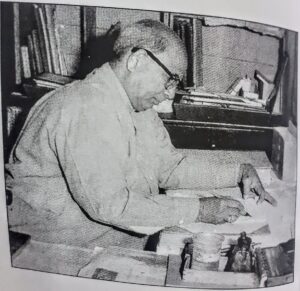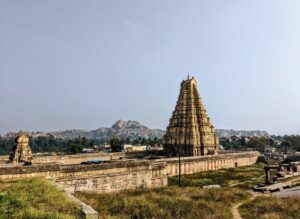DVG regarded Vidyaranya, the distinguished Advaita philosopher considered the founding father of Karnataka’s famous Vijayanagara empire, as a guru. His 'Mankutimmana Kagga' is often held to be Kannada literature’s Bhagavad Gita.

DV Gundappa, author of Kannada literature’s 'Bhagavad Gita' (Supplied)
Devanahalli Venkataramanaiah Gundappa, better known to the Kannada people as DVG, was famously called modern Kannada’s Sarvagna. (Sarvagna was a 16th-century Kannada poet-philosopher who achieved renown for his pithy and witty tripadis or tercets that explored life in its many dimensions.)
A renowned Kannada litterateur, journalist, editor, chronicler, poet, public intellectual, critic, scholar, philosopher, teacher, political savant, and freedom fighter, DV Gundappa was a model of probity and a polymath who acted as a dispassionate witness of his age.
DVG was born on 17 March 1887 in the village of Devanahalli, situated in the Mulabagilu taluk of the Kolar district (of present-day Karnataka).
Having finished his primary schooling in the Kannada medium in 1898, he taught himself Sanskrit out of an interest in the language and also learnt the basics of English.
He then moved to Maharaja High School in Mysore to continue his studies. After failing the matriculation exam (as it was called then), DVG discontinued his formal education.
DVG got married to Bhageerathamma when he was in high school.
After getting married, DV Gundappa worked for a while as a substitute teacher in Mulabagilu. That was the start of his professional career. Afterwards, he worked for a time in the Kolar gold mines and in a soda factory.
From there, DVG moved to Bengaluru in search of work. To maintain himself and his family, he wrote for several English newspapers. He also gained experience writing for Kannada newspapers.
He first made a name for himself through his translations of several well-known literary works into Kannada. From then on, political commentaries, philosophy, and matters related to dharma and religion became the subjects of his writing.

DV Gundappa wrote several books that offered prose commentaries for the layman about classical Hindu literature and philosophy (Supplied)
But it was through his Mankuthimmana Kagga and Marula Muniyana Kagga that DV Gundappa made an indelible name for himself in Kannada literature.
The former work, ಮಂಕುತಿಮ್ಮನ ಕಗ್ಗ (Mankuthimmana Kagga: The Ramblings of Mankuthimma, a deliberately self-deprecatory title), is a collection of 945 quatrains dealing with the multifariousness of life and is often held to be Kannada literature’s Bhagavad Gita.
In a well-known line from one of his quatrains in Mankuthimmana Kagga that goes “The beauty of the tree rises from the union of its fresh-sprouted shoots and age-old roots”, DVG unites the wisdom of tradition with the modernity of scientific discovery.
If one thinks of the varieties of language as three — prose, verse, and song — it would not be an exaggeration to say DVG made a substantial contribution to each variety.
The river of his literature flowed along several channels — lyric poetry, song poetry, contemplative poetry, plays, reminiscences, biography, and children’s literature.
If Mankuthimanna Kagga was DVG’s magnum opus in verse, his eight-volume Jnapaka Chitrashaale (A Picture House of Memories), a recollection of the many men (and some women) he met in his life, was his magnum opus in prose; it provides us with incisive profiles of dozens of people Gundappa came into contact with and includes the gifted and the ordinary, the famous and the regular.
All told, DV Gundappa’s canvas was such that he came to be called the Ashvatthavruksha (Peepul tree) of Kannada literature and his learning and intelligence were so profound that he was considered a rishi.
To quote the late Prof. HM Nayak, DVG’s literature was one that combined in equal measure satya (truth), shiva (goodness), and soundarya (beauty).
Among the books DV Gundappa wrote were several that offered prose commentaries for the layman about classical Hindu literature and philosophy.
These included Srirama Pareekshanam, Srikrishna Pareekshanam, Veda Vedanta: Ondu Sanna Parichaya (A Short Introduction to Veda and Vedanta), Upanishattugalu: Ondu Sanna Parichaya (A Short Introduction to the Upanishads), and Shrimadbhagavadgita Tatparya Saara (The Essence of the Bhagavad Gita).
His books Sahitya Shakti (The Power of Literature) and Kavya Svarasya (The Delight of Poetry) were written to attract lay readers to literature.
DV Gundappa’s interest in social welfare led him to start the Kannada newspapers, Bharat and Karnataka, and to found the Gokhale Institute of Public Affairs (GIPA) in Bengaluru.
His probity and talent also saw him nominated to a number of positions and brought him several honours.
He was the president of the 18th Kannada Sahitya Sammelana (Kannada Literary Congress) held in Madikeri in 1932, was nominated by Sir M Vishveshvarayya to the Bangalore Municipal Council in 1912, and was a member of the Senate of the University of Mysore.
Gundappa was also a recipient of the Padma Bhushan in 1974, the Sahitya Akademi award in 1967, and an honorary doctorate from the University of Mysore in 1961. In 1970, he was honoured by the Karnataka government for his services to Kannada literature.

From Hemakuta hill, a view of the Virupaksha temple in Hampi, the capital of the Vijayanagara empire (Prasanna RS)
DV Gundappa, who thought the grace of literature was the answer to life’s difficulties, believed the three essential principles of a well-lived life were: an awareness of the world and its matters; a critical cautiousness; and an elevated vision.
DVG adopted these principles from Vidyaranya, the distinguished Advaita philosopher considered the founding father of Karnataka’s famous Vijayanagara empire, whom he looked upon as a guru.
Another man he looked up to was Gopalakrishna Gokhale, whom he wrote a biography of and whose dictum “public life was to be spiritualised” he attempted to embody all through his own rich and long public life.
During his lifetime, DVG wrote more than 35 books, with Mankuthimmana Kagga being the most famous of them. A work that has been translated into several languages, including Tamil, Telugu, and English, the Kagga is arguably the greatest philosophical poem of 20th-century Kannada literature.
Devanahalli Venkataramanaiah Gundappa passed away in Bengaluru on 7 October 1975.
Bonus: Here is a sung portion of DVG’s poem ನಿವೇದನ (Nivedana) from his poetry collection of the same name. The song has been sung by SA Shivashankar.
(This article is a translation by Madhav Ajjampur of a write-up by Smt. Girija S. Deshpande. Smt. Girija holds a Master’s degree in Kannada from Karnatak University, Dharwad, and served as a Kannada teacher for 15 years. She has had over 3000 of her articles published in various Kannada magazines, journals, and newspapers and is the recipient of the 2019 Kannada Rajyotsava Sahityasri award for her accomplishments as a columnist. These are the personal views of the author)

Jul 25, 2024

Jul 25, 2024

Jul 25, 2024

Jul 24, 2024

Jul 24, 2024

Jul 23, 2024